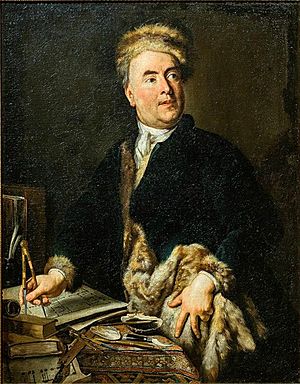Johann Lukas von Hildebrandt facts for kids
Quick facts for kids
Johann Lukas von Hildebrandt
|
|
|---|---|

Portrait, eighteenth century
|
|
| Born | 14 November 1668 |
| Died | 16 November 1745 (aged 77) |
| Occupation | Architect |
| Buildings |
|
Johann Lukas von Hildebrandt (born November 14, 1668 – died November 16, 1745) was a famous Austrian architect. He was also a military engineer. He designed many grand buildings and churches. His work greatly influenced the look of the Habsburg Empire in the 1700s.
Hildebrandt studied architecture in Rome. His teacher was Carlo Fontana. Later, he built strong fortresses for Prince Eugene of Savoy. This was during the Prince's military campaigns in Italy. Prince Eugene liked Hildebrandt's work so much that he became his favorite architect.
In 1700, Hildebrandt started working for the royal court in Vienna as an engineer. By 1711, he was in charge of the court's building department. He became the official court architect in 1723. His designs for palaces, large estates, gardens, churches, and villas were very popular. Many people copied his ideas. His architectural style spread across central and southeast Europe. Some of his most important buildings are Palais Schwarzenberg, St. Peter's Church, and Belvedere in Vienna. He also designed Savoy Castle in Ráckeve, Schönborn Palace in Göllersdorf, and Schloss Hof.
Contents
Early Life and Training
Johann Lukas von Hildebrandt was born on November 14, 1668. His birthplace was Genoa, which is in Italy. His mother was Italian and his father was German.
Hildebrandt learned a lot from his teachers. He studied architecture with C. Fontana in Rome. He also learned about civil and military engineering. He studied with Prince Eugene of Savoy in Rome and in Piedmont. Because of this training, Hildebrandt became Prince Eugene's favorite architect.
Working in Vienna
In 1696, Hildebrandt moved to Vienna, the capital of Austria. There, he worked for many important families. These included the Dauns, Harrachs, Schönborns, and Starhembergs. He also continued to work for Prince Eugene.
In 1700, Hildebrandt became an engineer for the Hofburg court. The Hofburg was the main imperial palace. By 1711, he was the head of the court's building department. In 1723, he became the Hofburg's court architect.
However, Hildebrandt faced some competition at the Hofburg. Two other famous architects, Johann Bernhard Fischer von Erlach and his son Joseph Emanuel Fischer von Erlach, were also working there. So, Hildebrandt mostly designed buildings for rich noble families instead of the main court.
Hildebrandt's buildings were different from the huge, grand works of Johann Bernhard Fischer von Erlach. Hildebrandt's designs often felt more personal. They also included more decorative details. This made his work popular with many people, including those who were not super rich. He combined ideas from Italian and French architecture. His style helped shape the baroque look in southern Germany and Austria.
Hildebrandt also helped with many big projects started by other architects. These included buildings in Würzburg, Göttweig Abbey, Pommersfelden, and Palais Schwarzenberg.
From 1713 to 1716, the wealthy Kinsky family hired him. He built their home, the Palais Kinsky, in Vienna. From 1723 onwards, he was the main inspector for all imperial buildings. His two most famous works are the Upper Belvedere (built 1721–1722) and the Lower Belvedere (built 1714–1716). Both of these were built for Prince Eugene of Savoy.
Hildebrandt also worked in Bavaria. He helped with the Pommersfelden castle, also known as Schloss Weißenstein. He designed many city palaces in Vienna, like the Daun-Kinsky Palace (1716). His churches are also very important. These include St. Peter's Church and Maria Treu Piaristenchurch in Vienna. He also designed the Teutonic Church in Linz and the Dominican Church in Gabel, Czech Republic.
Johann Lukas von Hildebrandt passed away on November 16, 1745, in Vienna.
Important Buildings by Hildebrandt
Here are some of the notable buildings designed by Johann Lukas von Hildebrandt:
- Stadtpalais des Prinzen Eugen, Vienna, Austria, 1695–98
- Sankt Laurentius, Jablonné v Podještedí, Czech Republic, 1699
- Loreto Chapel, Rumburk, Czech Republic, 1704-1709
- Palais Starhemberg-Schönburg, Vienna, Austria, 1705–06
- Palais Auersperg, Vienna, Austria, 1706–10
- Lower Belvedere, Vienna, Austria, 1714–16
- Piarist Church of Maria Treu, Vienna, Austria, 1716
- Schönborn Palace, Göllersdorf, Austria, 1712–17
- Geheime Hofkanzlei (Bundeskanzleramt), Vienna, Austria, 1717–19
- Imperial Crypt, Vienna, Austria, 1710–20
- Savoy Castle, Ráckeve, Hungary, 1702–22
- Palais Schwarzenberg, Vienna, Austria, 1697–1723
- Upper Belvedere, Vienna, Austria, 1721–23
- Deutschordenskirche Heilig Kreuz (Priesterseminarkirche), Linz, Austria, 1718–25
- Palais Kinsky, Vienna, Austria, 1713–26
- Schloss Hof, Schloßhof, Austria, 1729
- Hofburg Palace, Reichskanzleitrakt, Vienna, Austria, 1723–30
- St. Peter's Church, Vienna, Austria, 1702–33
- Palais Harrach, Pavillon and Januariuskapelle, Vienna, Austria, 1727–35
- Parish Church, Göllersdorf, Austria, 1740–41
- Würzburg Residence, Würzburg, Germany, 1720–44
- Haus zum Goldenen Adler, Wroclaw, Poland, 1750
Images for kids
See also
 In Spanish: Johann Lukas von Hildebrandt para niños
In Spanish: Johann Lukas von Hildebrandt para niños





















